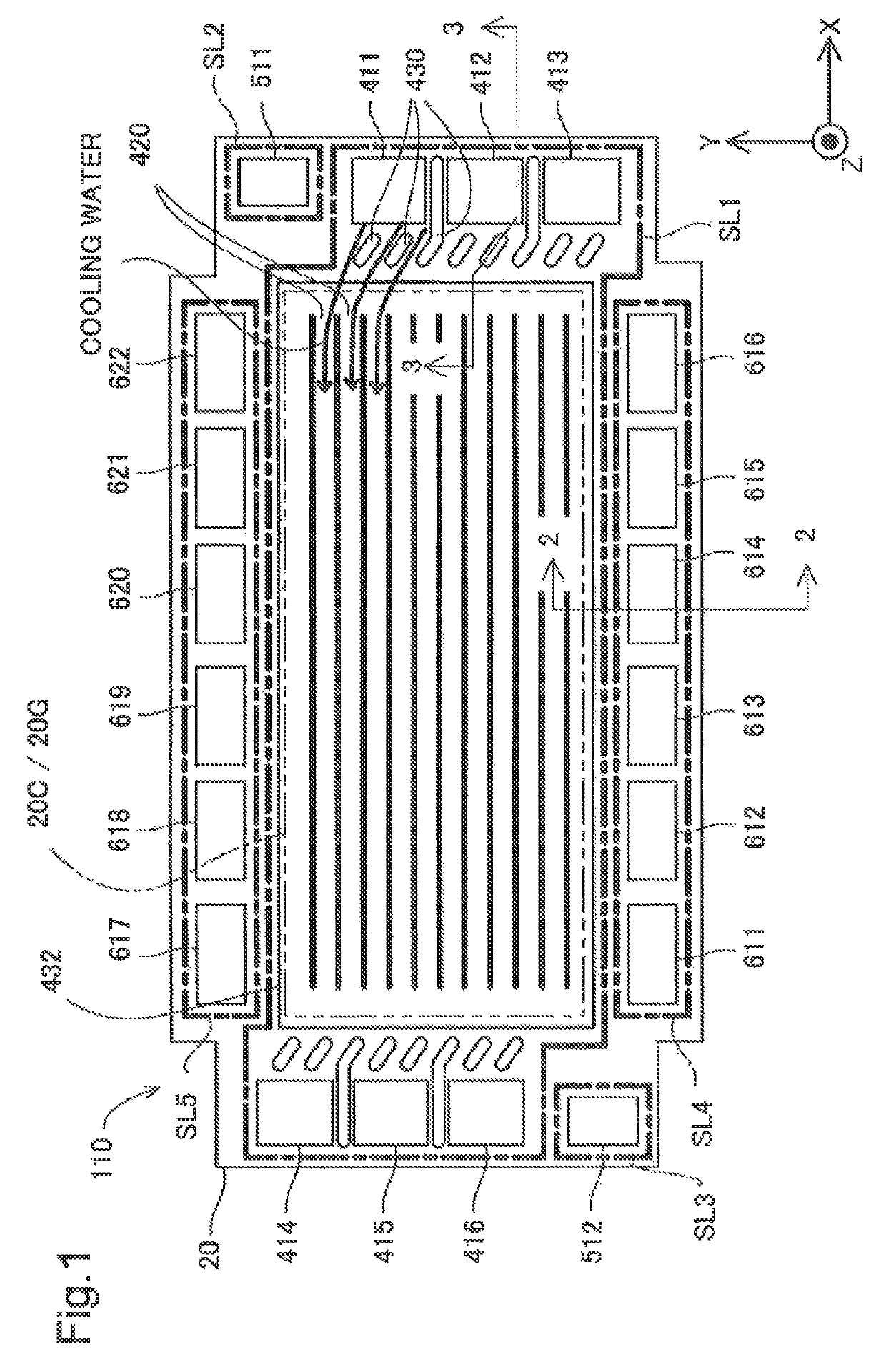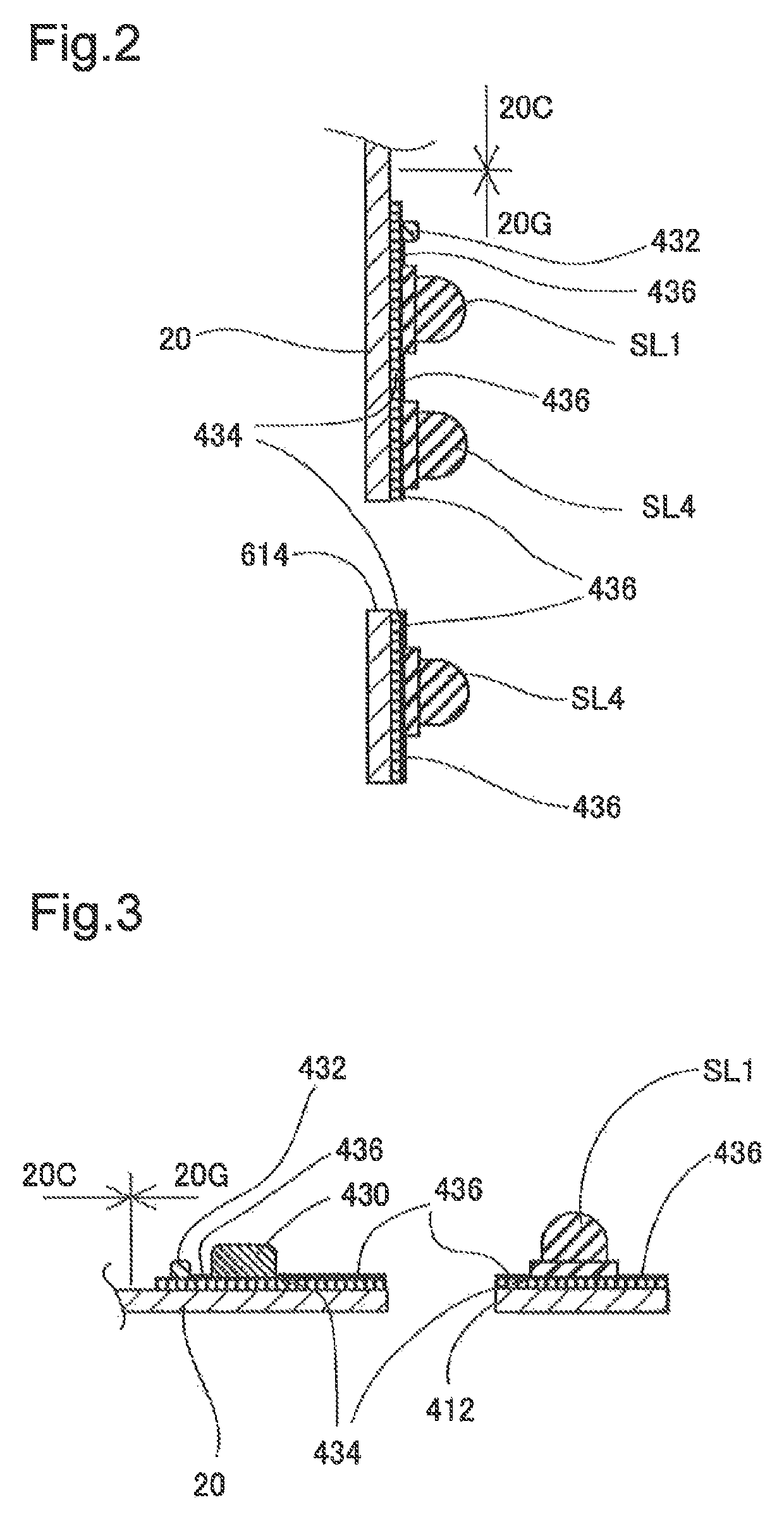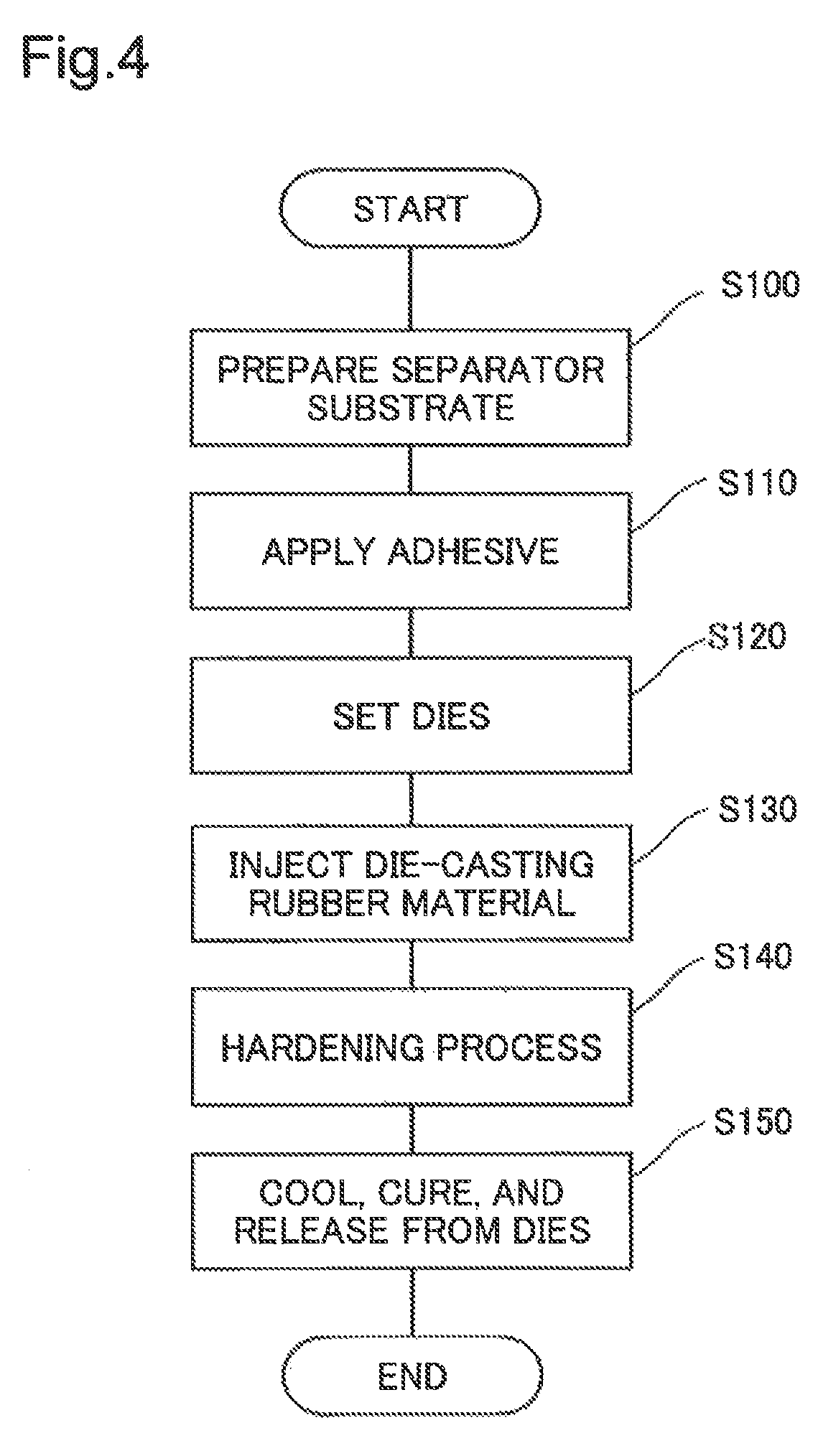[0009]As adopting the aspect described above, in the separator for the fuel cell, when forming the adhesive layer and the rubber molded body in the outer edge portion which extends toward the outer edge from the separator central area portion which opposes to the power generating area of the membrane electrode assembly, the adhesive layer can be formed prior to the formation of the rubber molded body, and the rubber molded body can be adhered by the adhesive layer. Since the rubber molded body is formed by die-casting the die-casting rubber material using the die, burrs may be formed during the die-casting in a membrane shape connected with the rubber molded body due to leaked die-casting rubber material when the die-casting rubber material leaks from between the die and the adhesive layer. Since the burr has the membrane shape, it does not affect the functions of the rubber molded body, for example, a sealing function in the outer edge portion and a rectifying function of fluid. However, if the burr is released from the rubber molded body, it may cause adverse effects to the functions of the rubber molded body. Thus, in the separator for the fuel cell of the aspect described above, the adhesive layer is formed in the adhesive layer area that includes and is larger than the area where the rubber molded body is die-casted in the outer edge portion, the membrane-shaped burr formed so as to be connected with the rubber molded body adheres to the outer edge portion by the adhesive layer. Therefore, if the separator for the fuel cell adopts the aspect described above, since the release and exfoliation of the burr from the rubber molded body can be reduced, the burr handling becomes simple, for example, at least a part of cutting of the burr becomes unnecessary, a possible damage to the rubber molded body accompanying the burr cutting can be avoided, etc.
[0010](2) In the separator for the fuel cell of the aspect described above, the separator may further include a central area portion side rubber molded body made of rubber. The central area portion side rubber molded body may be formed by die-casting the die-casting rubber material using the die, in the outer edge portion on the separator central area portion side from a position of the rubber molded body. The central area portion side rubber molded body may be die-casted from the die-casting rubber material that leaks from between the die and the adhesive layer when die-casting the rubber molded body, at a height lower than a height of the rubber molded body from a surface of the outer edge portion, and may be adhered to the outer edge portion by the adhesive layer. The central area portion side rubber molded body may be connected with the rubber molded body on a surface of the adhesive layer by a burr formed from the leaked die-casting rubber material. If the separator is configured as described above, there are the following advantages. The separator for the fuel cell of this aspect is provided with the central area portion side rubber molded body; however, it is separated toward the separator central area portion side from the rubber molded body, and, in addition, the height of the central area portion side rubber molded body from the surface of the outer edge portion is lower than that of the rubber molded body. Therefore, the influence to the functions of the rubber molded body, such as the sealing function and the rectifying function of fluid, can be reduced. Further, the central area portion rubber molded body is formed by the die-casting rubber material which leaked from between the die and the adhesive layer when die-casting the rubber molded body being collected in the die. Therefore, the leaked die-casting rubber material becomes difficult to move toward the separator central area portion side, compared with a formed part of the central area portion side rubber molded body. For this reason, a generation of a burr on the separator central area portion side can be reduced, and a situation where the power generating area of the membrane electrode assembly which opposes to the separator central area portion becomes narrow due to the burr can be reduced. This contributes to a reservation of the power generating area of the membrane electrode assembly, and, as the result, a retention of power generating performance of the fuel cell. Other than described above, since the burr which connects the central area portion side rubber molded body with the rubber molded body is adhered to the outer edge portion by the adhesive layer, it becomes difficult to cause the release and exfoliation of the burr.
[0011](3) According to another aspect of the invention, a method of manufacturing a separator is provided. The method of manufacturing the separator to be disposed opposing to a membrane electrode assembly includes forming an adhesive layer by applying thermosetting adhesive to an outer edge portion located in an outer edge of a separator central area portion opposing to a center area of the membrane electrode assembly that concerns generating power, placing the separator, where the adhesive layer is formed, in die having cavities for die-casting a rubber molded body made of rubber, injecting die-casting rubber material into the cavities to die-cast the rubber molded body, and curing by heat the adhesive of the adhesive layer to obtain an adhesive effect and hardening the injected die-casting rubber material. The forming the adhesive layer includes applying the adhesive over an adhesive layer area that includes and is larger than an area where the rubber molded body is die-casted in the outer edge portion. As adopting this aspect, the separator with no damage or less damage to the rubber molded body can easily be manufactured.
[0012](4) According to still another aspect of the invention, a fuel cell is provided. The fuel cell includes a cell stack formed by stacking a plurality of unit cells. Each of the unit cells is configured as a power generation unit. The unit cell includes the separator for the fuel cell of the aspect described above so as to oppose to the membrane electrode assembly that is formed by joining catalyst electrode layers on both membrane surfaces of an electrolyte membrane. Thus, since the fuel cell has the separator with less damage to the rubber molded body, an improvement in durability and an extension of life of the fuel cell are possible. Further, according to the fuel cell of the aspect described above, since a separator is replaced in an existing fuel cell, a reduction in manufacturing cost is possible.
 Login to View More
Login to View More 


